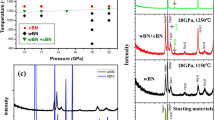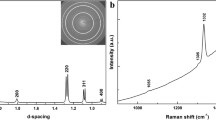Abstract
Nanotwinned cubic boron nitride (nt-cBN) with remarkable hardness, toughness, and stability has attracted widespread attention due to its distinct scientific and industrial importance. The key for nt-cBN synthesis is to adopt an onion-like BN (oBN) nano-precursor and induce phase transition under high pressure. Here, we found that the size change of oBN used greatly affected the mechanical performance of products. With the precursor size decreasing from ~320 to 90 nm, the Vickers hardness of nanostructured products improved from 61 to 108 GPa, due to the fact that large oBN nanoparticles possessed more flattened, orderly and graphite-like shell layers, in sharp contrast to the highly wrinkled and imperfect layers in small-diameter nanoparticles, thus resulting in the apparent reduction of ultrafine-twin substructure in the synthetic products. This study reveals that only small oBN precursor could produce complete ultrafine nt-cBN with outstanding performance. A practical route was proposed to further improve the performance of this important material.
摘要
拥有极高硬度、 韧性和稳定性的纳米孪晶立方氮化硼(nt-cBN)在材料领域备受关注. 前期研究表明, 在高温高压条件下以洋葱式氮化硼(oBN)为前驱物是合成nt-cBN的关键. 本文研究发现, 前驱物oBN的粒径变化会显著影响最终产物的组织结构和机械性能. 随着前驱物oBN的粒径从~320 nm减小到~90 nm, 合成的纳米结构块材的硬度从61 GPa逐渐提高到108 GPa. 表明大粒径的oBN拥有和普通六方氮化硼类似的平整、有序的外层结构, 这与小粒径的oBN纳米粒子中存在大量弯曲、褶皱的氮化硼原子层及高密度层错的结构特点形成鲜明对比; 大粒径oBN前驱物中的这些有序结构显著减少了最终产物中超细孪晶亚结构的含量, 从而导致相应产物硬度的下降. 本研究表明, 只有粒径足够小的oBN前驱物才能合成出拥有高密度超细纳米孪晶结构且性能优异的nt-cBN. 为进一步提高此类纳米孪晶材料的性能提供了一种切实可行的方案.
Similar content being viewed by others
References
Wentorf Jr. RH. Cubic form of boron nitride. J Chem Phys, 1957, 26: 956
Liew WYH, Yuan S, Ngoi BKA. Evaluation of machining performance of STAVAX with PCBN tools. Int J Adv Manufact Tech, 2004, 23: 11–19
Wentorf RH, Devries RC, Bundy FP. Sintered superhard materials. Science, 1980, 208: 873–880
Krauss AR, Auciello O, Gruen DM, et al. Ultrananocrystalline diamond thin films for MEMS and moving mechanical assembly devices. Diamond Related Mater, 2001, 10: 1952–1961
Dubrovinskaia N, Solozhenko VL, Miyajima N, et al. Superhard nanocomposite of dense polymorphs of boron nitride: Noncarbon material has reached diamond hardness. Appl Phys Lett, 2007, 90: 101912
Solozhenko VL, Kurakevych OO, Le Godec Y. Creation of nanostuctures by extreme conditions: High-pressure synthesis of ultrahard nanocrystalline cubic boron nitride. Adv Mater, 2012, 24: 1540–1544
Sumiya H, Uesaka S, Satoh S. Mechanical properties of high purity polycrystalline cBN synthesized by direct conversion sintering method. J Mater Sci, 2000, 35: 1181–1186
Dub SN, Petrusha IA. Mechanical properties of polycrystalline cBN obtained from pyrolytic gBN by direct transformation technique. High Pressure Res, 2006, 26: 71–77
Tian Y, Xu B, Yu D, et al. Ultrahard nanotwinned cubic boron nitride. Nature, 2013, 493: 385–388
Petch NJ. The cleavage strength of polycrystals. J Iron Steel Inst, 1953, 174: 25–28
Hall EO. The deformation and ageing of mild steel: III Discussion of results. Proc Phys Soc B, 1951, 64: 747–753
Lu L, Chen X, Huang X, et al. Revealing the maximum strength in nanotwinned copper. Science, 2009, 323: 607–610
Huang Q, Yu D, Xu B, et al. Nanotwinned diamond with unprecedented hardness and stability. Nature, 2014, 510: 250–253
Hu W, Wen B, Huang Q, et al. Role of plastic deformation in tailoring ultrafine microstructure in nanotwinned diamond for enhanced hardness. Sci China Mater, 2017, 60: 178–185
Zhao Z, Xu B, Tian Y. Recent advances in superhard materials. Annu Rev Mater Res, 2016, 46: 383–406
Sumiya H, Harano K, Ishida Y. Mechanical properties of nanopolycrystalline cBN synthesized by direct conversion sintering under HPHT. Diamond Related Mater, 2014, 41: 14–19
Kurakevych OO, Solozhenko VL. High-pressure design of advanced BN-based materials. Molecules, 2016, 21: 1399
San-Miguel A. Nanomaterials under high-pressure. Chem Soc Rev, 2006, 35: 876
Tang C, Bando Y, Huang Y, et al. Synthetic routes and formation mechanisms of spherical boron nitride nanoparticles. Adv Funct Mater, 2008, 18: 3653–3661
Leinenweber KD, Tyburczy JA, Sharp TG, et al. Cell assemblies for reproducible multi-anvil experiments (the COMPRES assemblies). Am Miner, 2012, 97: 353–368
Wang Y, Rivers M, Sutton S, et al. The large-volume high-pressure facility at GSECARS: A “Swiss-army-knife” approach to synchrotron- based experimental studies. Phys Earth Planet Inter, 2009, 174: 270–281
Solozhenko VL, Dub SN, Novikov NV. Mechanical properties of cubic BC2N, a new superhard phase. Diamond Related Mater, 2001, 10: 2228–2231
Evans AG, Charles EA. Fracture toughness determinations by indentation. J Am Ceramic Soc, 1976, 59: 371–372
He LL, Akaishi M, Horiuchi S. Structural evolution in boron nitrides during the hexagonal-cubic phase transition under high pressure at high temperature. Microsc Res Tech, 1998, 40: 243–250
Xiong C, Tu W. Synthesis of water-dispersible boron nitride nanoparticles. Eur J Inorg Chem, 2014, 19: 3010–3015
Zhao Z, Yang Z, Wen Y, Wang Y. Facile synthesis and characterization of hexagonal boron nitride nanoplates by two-step route. J Am Ceram Soc, 2011, 94: 4496–4501
Sachdev H. Influence of impurities on the morphology and Raman spectra of cubic boron nitride. Diamond Related Mater, 2003, 12: 1275–1286
Huang JY, Zhu YT. Advances in the synthesis and characterization of boron nitride. DDF, 2000, 186-187: 1–32
Britun VF, Kurdyumov AV. Mechanisms of martensitic transformations in boron nitride and conditions of their development. High Pressure Res, 2000, 17: 101–111
Zheng S, Zhang R, Huang R, et al. Structure and energetics of nanotwins in cubic boron nitrides. Appl Phys Lett, 2016, 109: 081901
Chen CL, Huang R, Wang Z, et al. Microstructures and grain boundaries of cubic boron nitrides. Diamond Related Mater, 2013, 32: 27–31
Oku T, Hiraga K, Matsuda T, et al. Twin structures of rhombohedral and cubic boron nitride prepared by chemical vapor deposition method. Diamond Related Mater, 2003, 12: 1138–1145
Tian Y, Xu B, Yu D, et al. Tian et al. reply. Nature, 2013, 502: E2–E3
Chaudhri MM, Lim YY. Harder than diamond? Just fiction. Nat Mater, 2005, 4: 4
Sumiya H, Ishida Y, Arimoto K, et al. Real indentation hardness of nano-polycrystalline cBN synthesized by direct conversion sintering under HPHT. Diamond Related Mater, 2014, 48: 47–51
Brookes CA, Moxley B. A pentagonal indenter for hardness measurements. J Phys E-Sci Instrum, 1975, 8: 456–460
Corrigan FR, Bundy FP. Direct transitions among the allotropic forms of boron nitride at high pressures and temperatures. J Chem Phys, 1975, 63: 3812–3820
Acknowledgements
We acknowledge the financial support of the National Natural Science Foundation of China (51472213, 51332005, 51572235, 51722209 and 51525205) and the National Key R&D Program of China. Zhao Z also acknowledges the 100 Talents Plan of Hebei Province (E2016100013), the Natural Science Foundation for Distinguished Young Scholars of Hebei Province of China (E2018203349), and the Key R&D Program of Hebei Province of China (17211110D). Luo K acknowledges China Postdoctoral Science Foundation (2017M620097).
Author information
Authors and Affiliations
Corresponding authors
Additional information
Kun Luo is a postdoctoral fellow at the School of Science, Yanshan University. He received his PhD degree from Yanshan University in 2017. His research interest includes the design and synthesis of novel metastable materials under HPHT.
Zhisheng Zhao is a professor at the College of Materials Science and Engineering, Yanshan University. He received his PhD degree from Yanshan University in 2012. His research interest focuses on the design and synthesis of novel metastable materials and theoretical calculation.
Rights and permissions
About this article
Cite this article
Luo, K., Zhang, Y., Yu, D. et al. Small onion-like BN leads to ultrafine-twinned cubic BN. Sci. China Mater. 62, 1169–1176 (2019). https://doi.org/10.1007/s40843-019-9409-1
Received:
Accepted:
Published:
Issue Date:
DOI: https://doi.org/10.1007/s40843-019-9409-1




